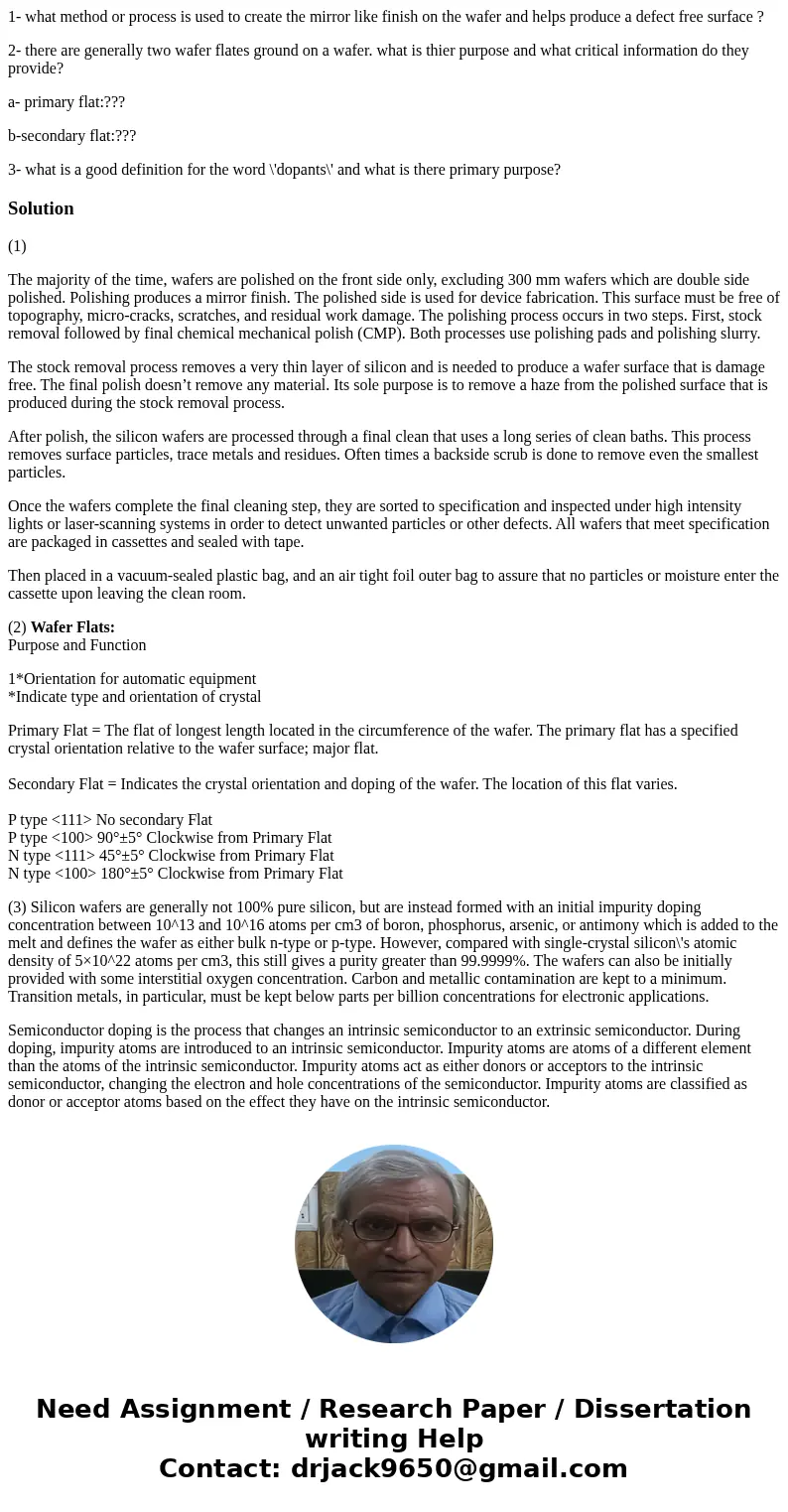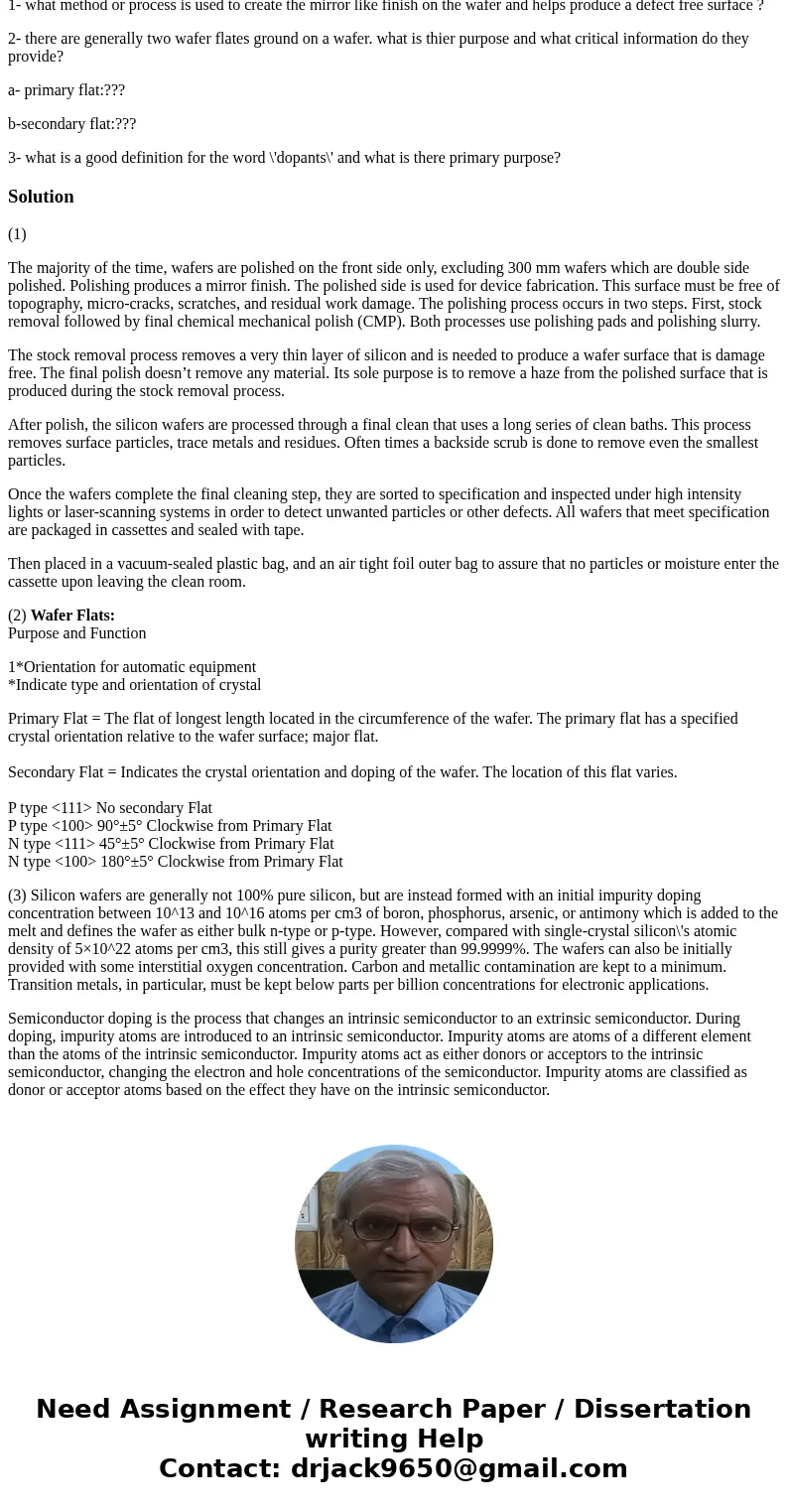1 what method or process is used to create the mirror like f
1- what method or process is used to create the mirror like finish on the wafer and helps produce a defect free surface ?
2- there are generally two wafer flates ground on a wafer. what is thier purpose and what critical information do they provide?
a- primary flat:???
b-secondary flat:???
3- what is a good definition for the word \'dopants\' and what is there primary purpose?
Solution
(1)
The majority of the time, wafers are polished on the front side only, excluding 300 mm wafers which are double side polished. Polishing produces a mirror finish. The polished side is used for device fabrication. This surface must be free of topography, micro-cracks, scratches, and residual work damage. The polishing process occurs in two steps. First, stock removal followed by final chemical mechanical polish (CMP). Both processes use polishing pads and polishing slurry.
The stock removal process removes a very thin layer of silicon and is needed to produce a wafer surface that is damage free. The final polish doesn’t remove any material. Its sole purpose is to remove a haze from the polished surface that is produced during the stock removal process.
After polish, the silicon wafers are processed through a final clean that uses a long series of clean baths. This process removes surface particles, trace metals and residues. Often times a backside scrub is done to remove even the smallest particles.
Once the wafers complete the final cleaning step, they are sorted to specification and inspected under high intensity lights or laser-scanning systems in order to detect unwanted particles or other defects. All wafers that meet specification are packaged in cassettes and sealed with tape.
Then placed in a vacuum-sealed plastic bag, and an air tight foil outer bag to assure that no particles or moisture enter the cassette upon leaving the clean room.
(2) Wafer Flats:
Purpose and Function
1*Orientation for automatic equipment
*Indicate type and orientation of crystal
Primary Flat = The flat of longest length located in the circumference of the wafer. The primary flat has a specified crystal orientation relative to the wafer surface; major flat.
Secondary Flat = Indicates the crystal orientation and doping of the wafer. The location of this flat varies.
P type <111> No secondary Flat
P type <100> 90°±5° Clockwise from Primary Flat
N type <111> 45°±5° Clockwise from Primary Flat
N type <100> 180°±5° Clockwise from Primary Flat
(3) Silicon wafers are generally not 100% pure silicon, but are instead formed with an initial impurity doping concentration between 10^13 and 10^16 atoms per cm3 of boron, phosphorus, arsenic, or antimony which is added to the melt and defines the wafer as either bulk n-type or p-type. However, compared with single-crystal silicon\'s atomic density of 5×10^22 atoms per cm3, this still gives a purity greater than 99.9999%. The wafers can also be initially provided with some interstitial oxygen concentration. Carbon and metallic contamination are kept to a minimum. Transition metals, in particular, must be kept below parts per billion concentrations for electronic applications.
Semiconductor doping is the process that changes an intrinsic semiconductor to an extrinsic semiconductor. During doping, impurity atoms are introduced to an intrinsic semiconductor. Impurity atoms are atoms of a different element than the atoms of the intrinsic semiconductor. Impurity atoms act as either donors or acceptors to the intrinsic semiconductor, changing the electron and hole concentrations of the semiconductor. Impurity atoms are classified as donor or acceptor atoms based on the effect they have on the intrinsic semiconductor.


 Homework Sourse
Homework Sourse